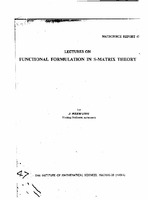- DSpace Home
- →
- MATSCIENCE Reports
- →
- MATSCIENCE Reports
- →
- View Item
JavaScript is disabled for your browser. Some features of this site may not work without it.
| dc.contributor.author | Rzewuski, J. | |
| dc.date.accessioned | 2010-08-09T05:37:42Z | |
| dc.date.available | 2010-08-09T05:37:42Z | |
| dc.date.issued | 2010-08-09T05:37:42Z | |
| dc.date.submitted | 1966 | |
| dc.identifier.uri | https://dspace.imsc.res.in/xmlui/handle/123456789/214 | |
| dc.description.abstract | Collision processes between elementary particles are mathematically described by functions depending on several points of space-time, or of the momentum space. Those, so called n-point functions or rather the generating functionals for these functions will be the subject of this volume. This lectures are based on considerations of two principles namely, Relativistic Invariance and Microscopic causality - being the basis for the theory of collision processes. Since this volume is devoted mainly to the description of functional methods, the principles of invariances other than Relativistic Invariance are not considered here. Mathematical preliminaries connected with functionals are contained in Chapter I. Chapter II introduces the notion of functional metrices and the corresponding calculus, in particular with respect to the functional metrices encountered in the S-Matrix theory. The notion of Scattering Matrix (S-Matrix) is introduced in Chapter III. Derivation of various forms of the causality condition and the approximative treatment of the corresponding equations are given in this chapter. Chapter IV introduces the notion of interaction functional in terms of S-Matrix. It is shown formally that the conditions of reality and locality for the interaction functional are equivalent with the conditions of generalized unitarity and causality for the S-Matrix. It also derives the canonical from the functional formalism. Generalizations of the functional formalism to charged spin 0 and spin(1/2) particles and to photons are the subject of Chapter V. The theory developed in the first five chapters is based entirely on the notion of functional derivatives and functional differential operations although possibly of infinite order(Volterra Expansion, definition of interaction functional). Functional integration is introduced in Chapter VI, and several related problems such as transformation of variables in functional integrals, functional Fourier transformations, and orthonormal expansions in terms of Hermito Functionals. Chapter VII deals with the theory in terms of functional integrals and some explicit calculations are carried out. Most of the considerations based on the causality principle, lead to divergent difficulties. Therefore, Chapter VIII considers a mathematical device by means of which the divergent quantities may be represented as the limits of well defined quantities. The procedure is based on the theory of higher order differential equations. Several important subjects concerning n-point functions are not treated in this report(eg., - the renormalization theory and dispersion relations) as already emphasized that this volume is devoted mainly to the presentation of functional methods. Any Modern monographs on Quantum Field theory in conventional presentation may deal with these topics which are left out here. | en_US |
| dc.subject | Functional Formulation | en_US |
| dc.subject | Matscience Report 47 | en_US |
| dc.title | Lectures on Functional Formulation in S-Matrix theory[MatSciRep:47] | en_US |
| dc.type.institution | Institute of Mathematical Sciences | en_US |
| dc.description.pages | 286p. | en_US |
| dc.type.mainsub | Mathematics | en_US |
